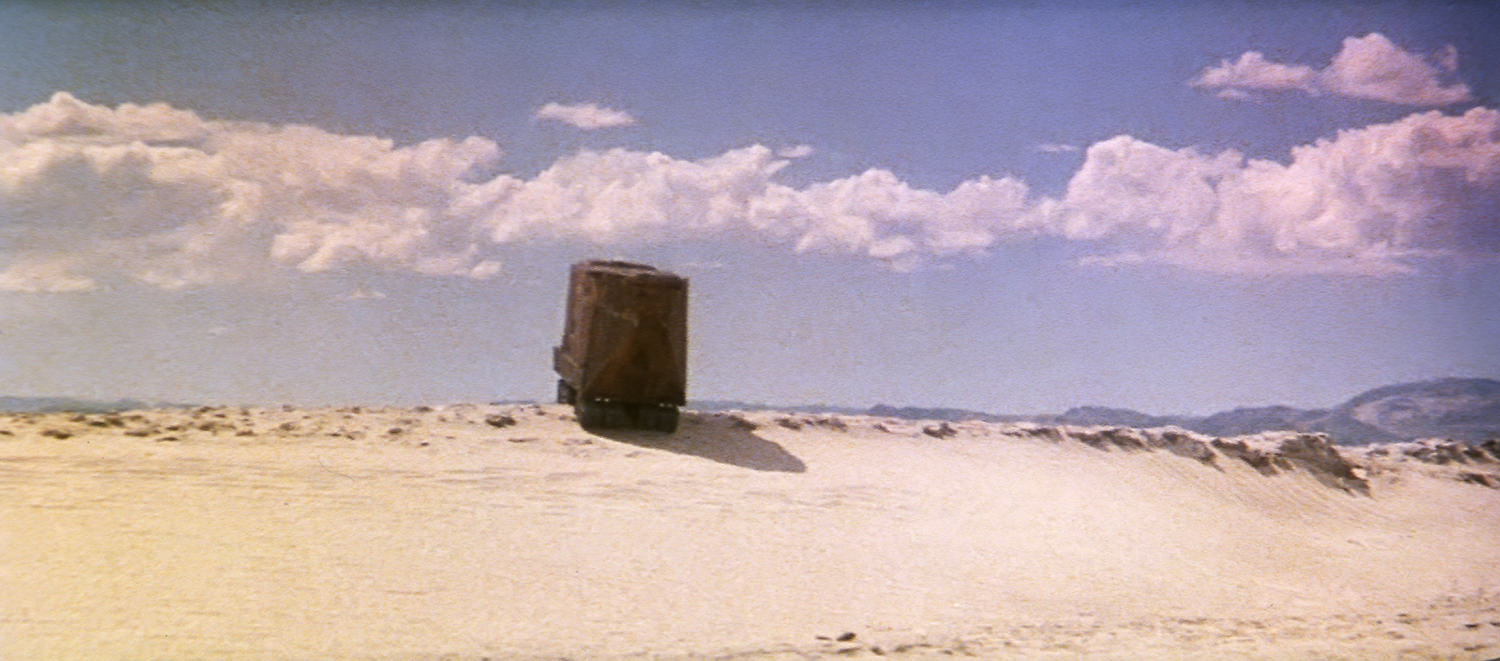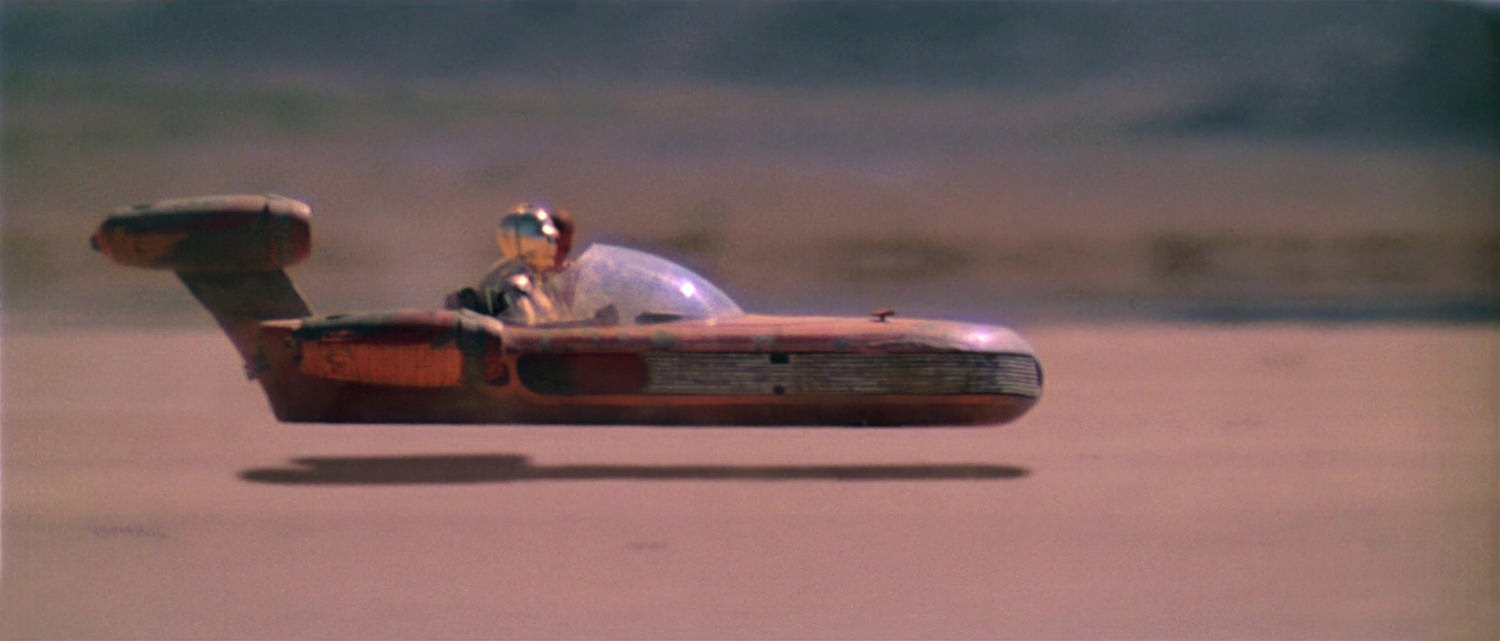Unless you've shut yourself off from ALL modern media and cut off all social contact as well, you are probably well aware that a new STAR WARS film is almost upon us. The first of many, so reports say. Because of that and since this is my least busy time of the year, I thought it might be interesting to go back to the original trilogy and indeed, the first film.
If you've read this site for any amount of time, you might recall that I blogged about visiting the STAR WARS filming locations in Tunisia. A number of years after that experience, I made a series of trips to Death Valley, where a number scenes from the original film were filmed in January and February of 1977. Six years after that first bit of filming, a small production crew from RETURN OF THE JEDI returned to Death Valley for a single-day location shoot of a scene for that film.
However, before I get too far into those locations, I thought I'd take this post and address a few shots from STAR WARS - EPISODE IV - A NEW HOPE that are often associated with Death Valley, but apparently weren't actually shot there.
Randsburg Mining Tailings & The Sandcrawler
While part of the lower section of the Jawa's sandcrawler was constructed on location in Tunisia. However, to work within the film's modest budget, a miniature was built for the few shots of it actually traveling across the Tatooine desert. This motorized model was shot on location in California's Mojave Desert. As those involved recall...
... Grant McCune, Lorne Peterson, Joe Johnston, and others began photography of the miniatures on location. “I think there were six trips made to the desert,” Johnston says. “Four were made just to shoot the sandcrawler; on two others they took the landspeeder along for canyon shots. The sandcrawler was constantly breaking down: the tracks would jam, the tread would come off. The sandcrawler probably ended up costing more per second than anything else in the film, because it involved taking that model, a camera, and a crew of six guys out to the desert, where they usually had to spend the night. We left the model once in a van, and it got cold that night. We were in a motor home twenty yards away, but we could hear the pieces of styrene popping and cracking on the model.”
On the first trip one of the sandcrawler’s inner lightbulbs broke and they didn’t have a replacement; the second time it was too windy and cloudy; on the third trip the lighting exposure was done incorrectly; only the fourth shoot was perfect.
- Excerpt from The Making Of Star Wars, pp. 249, by J.W. Rinzler
Lorne Peterson elaborates...
Three of the original staff at ILM were licensed pilots and our facility just happened to be located near the Van Nuys airport. John Dykstra, Bob Shepherd, and Grant McCune actually owned a plane, so we’d spend the occasional lunch hour flying. It wasn’t all joyriding; we used the high vantage point to scout locations for miniature shoots. On one such trip, the guys spotted the visually rich topography of the desert near Randsberg, not far from Lake Mirage. The place was lined with mine tailings: runoff from the water pumps used to scour the area for valuable metals. Pumped out by mining crews, incredible amounts of dirty sand would settle, sedimentary layer by layer, to resemble a miniature Grand Canyon with walls six to ten feet tall. The mixtures of runoff gave the land a striated look, a perfect environment for our sandcrawler to explore.
The finished twenty-inch-tall model was a powerful thing. With only its right side fully completed, the left half had a gap to access the heavy-duty motorcycle batteries running the treads. The motorized model could pop a wheelie, or a rider could sit on it and drive him/herself around by remote control. It may have been over-muscled, but that’s a standard filmmaking precaution. Without knowing exactly what the vehicle would be called to do, no one wanted to be in the position of having to say, “No, it can’t do that.”
The sandcrawler’s boxy body was comprised of Finnish birch ply, with a steel structure supporting its lower portion. The tail end had large cylinders taken from a Hawker Harrier VTOL jet models. An illustration by Joe Johnston showed the forward sweep of the crawler’s body consisting of irregular angles – planes that couldn’t match up in real life. Without compromising the integrity of the design, we made it work by adding another plane to connect it. We discovered pretty quickly that a lot of things could be drawn on paper but couldn’t necessarily be constructed in exactly the same way. Regardless, capturing the feel and essence of the original illustration was always the ultimate goal.
Building the sandcrawler’s caterpillar treads was quite a challenge. Not only were there four sets of double tracks, but they also had to match a full-sized set of treads built in Tunsia – and they had to work. Grant McCune, Bob Shourt, and Jamie Shourt puzzled out the mechanics and discovered that a model tank kit by Tamiya actually had functional metal treads. The tread in the kit was only about one-and-a-half inches wide, so Steve Gawley had to create an additional inch. Our versions were glued to the outside of the kit treads, retaining their structure and functionality but adding enough detail to make it uniquely a sandcrawler.
With 250 treads to fashion, the project was very labor-intensive. I mentioned to production manager Bob Shepherd that it was a pitty we didn’t have an injection molder, a device Jon Erland and I were quite familiar with in our industrial background but that wasn’t typically found in effects facilities. I told Bob it would make our work go much faster – and he exclaimed, “Get it!” Without that essential tool at our disposal, those treads would have taken much longer to produce. I was learning the old adage that time is money.
With the model now completed, we took the sandcrawler to Randsberg to shoot. It’s really only two shots: one driving away into the night after picking up R2-D2, and the other cresting a sand dune on the morning of the droid auction. To capture the latter, we dug a hole two or three feet deep and placed the camera inside in order to achieve a convincing horizon line. The hill it traversed was only three inches tall. This shot would ultimately be replaced in the Special Edition with a more dynamic close-up of the sandcrawler.
John Knoll supervised that shot for the 1997 re-release. A testament to his ability to problem-solve both practically and digitally, he calculated, at home, exactly how much miniature set would need to be constructed to accommodate the shot. The virtual camera on his home computer plotted the sandcrawler’s movements and determined what would be visible around it. In the pre-digital age, we would likely have overbuilt the environment by twenty percent – a comfortable amount of desert landscape as wiggle room. With Knoll’s pre-visualization, he knew precisely what lens to use and what would appear in frame.
With his exact requirements, we arranged several tables of finely ground walnut shells for sand with two-to-three-pound density carved foam as rocky outcroppings. We shot it outside on the roof of ILM, on a beautiful Marin County day, clear but for several perfectly placed clouds. For the Special Edition, I made a little Jawa that fit into the sandcrawler’s side hatch. He was a little over half-an-inch tall. I doubt whether anybody can actually see him, but he’s there…
- Excerpt from Sculpting A Galaxy, p. 79-77, by Lorne Peterson
Getting There
Randsberg (occasionally noted on maps as "Randsburg") is a small town in southwestern California. It's located on HWY 395, northeast of Edwards Air Force Base, south of Naval Air Weapons Station China Lake (North Range) and southwest of Naval Air Weapons Station China Lake (South Range). There is evidence of mining in the hills directly south of the town. This may or may not have been the location reference in the above excerpt. See also: wikimapia | googlemaps
Lake Mirage & The Landspeeder
Shots of the full-size landspeeder racing across the desert were realized in pickup shots also filmed on location in the Mojave. It has long been assumed by fans and journalists that these shots were completed in Death Valley. I have also seen Owen's Lake mentioned a time or two. It's possible that those locations were used, however I'm more inclined to believe more recent comments made from those who were actually involved with the filming.
“We tried several ideas during filming, and none of them seemed to work,” Lucas says (regarding the landspeeder's hovering effect). “We finally tried using a mirror, and that came close, but it didn’t work, either. So when we went out to Death Valley, we redid the mirror and made it sturdier and made it longer, raised the car a little bit higher, and found a lake bed that had topography that was easier to work with. Then we shot it again, but that didn’t work because not enough care was taken to make the mirror and to get the speeder going fast enough. Finally, Bob Dalva came back with a crew and made it work. But he only got one shot, and we needed three. So then we sent another cameraman to get the final two shots using the same method.”
Excerpt from The Making Of Star Wars, p. 251, by J.W. Rinzler
Heh! Even George references Death Valley! I suppose it's a generic way to describe the area (although Mojave Desert is more accurate). Again, Lorne Peterson provides clarification...
The Model Shop helped out with the full-sized (Land)speeder when it came to the U.S. for late pickup shots in early 1977. We constructed a mirrored plex skirt that blocked the view of the landspeeder’s three tires, the true source of its propulsion. The mirror reflected the deset landscape underneath, creating the illusion of anti-gravity. We shot these scenes near Lake Mirage, the locale close to where our sandcrawler explored.
- Excerpt from Sculpting A Galaxy, p. 81, by Lorne Peterson
Getting There
I haven't been able to locate a "Lake Mirage." I'm assuming that it is actually El Mirage Lake which is located immediately north of the desert community of El Mirage - itself located 72 miles south of Randsberg off HWY 395. See also: wikimapia | googlemaps
Further Thoughts
As far as I am aware, no one (beyond those who worked on the film) has successfully matched up the sandscrawler and/or landspeeder shots from the film with the present day locations. I certainly haven't seen anything on the internet that could be called definitive. The closest I've come across bears a passing resemblance, but upon closer inspection, the shots don't quite match up precisely - at least not to my eye.
It's not really surprising. Even though the two sandcrawler shots were filmed in desert locations, erosion has likely rendered the precise shooting locations unrecognizable after forty odd years. And the landspeeder shots are difficult to match up with anything due to their inherent motion blur. However, there are a number of behind-the-scenes photos of both the landspeeder and sandcrawler shoots floating around the internet, so a determined fan (or fans) could conceivably get close.
It's also possible that those involved with the original filming could offer more specifics. Lorne Peterson and a number of others who worked on the original film are on social media such as facebook and do engage in conversation with fans. But I'll leave that to them (and you!).
For now let's move on to Death Valley itself ... starting with The Mos Eisley Overlook!











